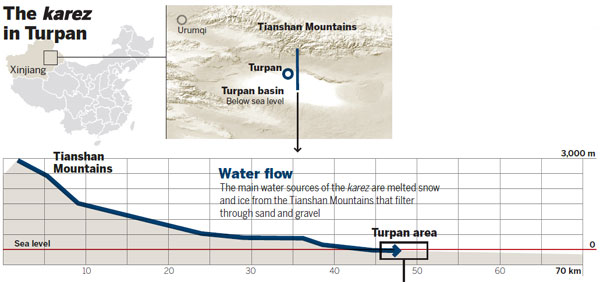|
|
Despite being more than 2,000 years old, the ancient karez irrigation system used in the areas around the ancient Silk Road city is still in use. Now, new developments are likely to reinforce the canal's importance, as Cui Jia reports.
Ablimit Yagup watched carefully as his son Ablikim was lowered into a narrow opening in the Gobi Desert near Turpan city in the Xinjiang Uygur autonomous region. The 53-year-old then tied the steel wire around his own waist so he could descend to the bottom of the 30-meter-deep shaft and join Ablikim. From the base of the shaft, the two men entered a muddy subterranean canal filled with slow-running water.
The locals say that what runs in the canal, or karez, which means "well" in the Uygur language, is not water, but the very blood of Turpan itself. People have lived around the oasis settlement for millennia, and merchants, monks and preachers traversing the ancient Silk Road trade route knew the area as an important strategic point for refreshment and replenishment of supplies.
Ablimit and his son are following in the family tradition. Like previous generations, their job is to remove the sodden sand that clogs the local karez to keep the blood of Turpan circulating.
"Without the invention of the karez, Turpan, which has prospered under different kingdoms and religions throughout history, simply wouldn't exist," said Chen Xinwei of the Turpan Cultural Relics Bureau, who has been working to preserve the ancient man-made structures, many of which are still in use, despite being built more than 2,000 years ago.


